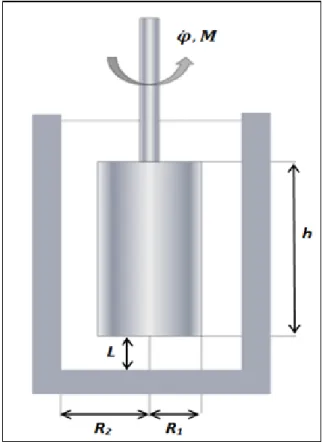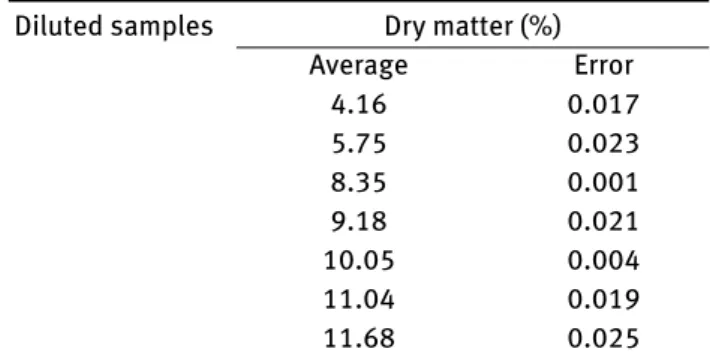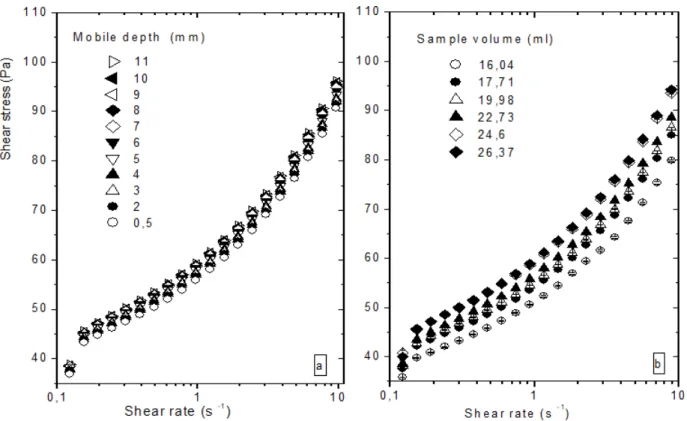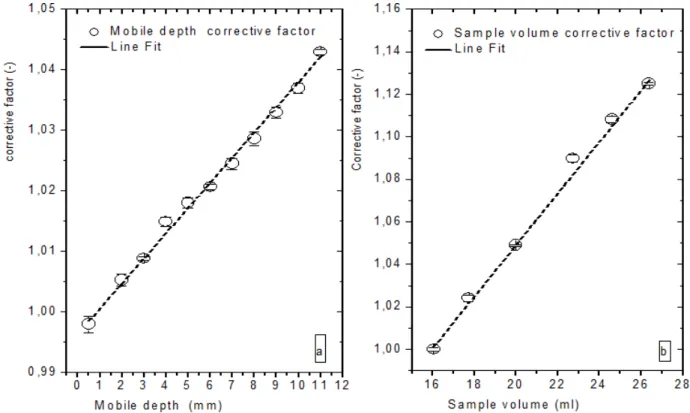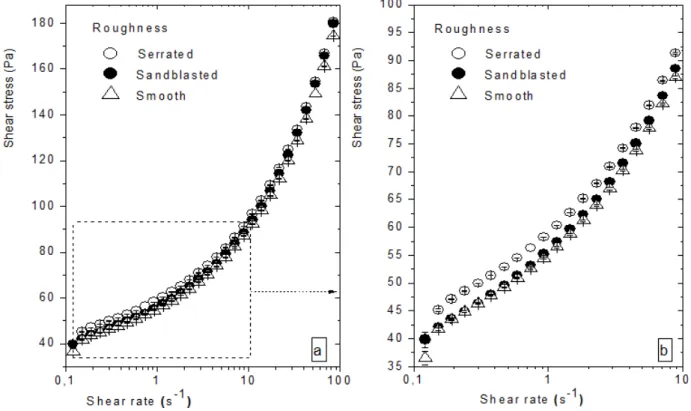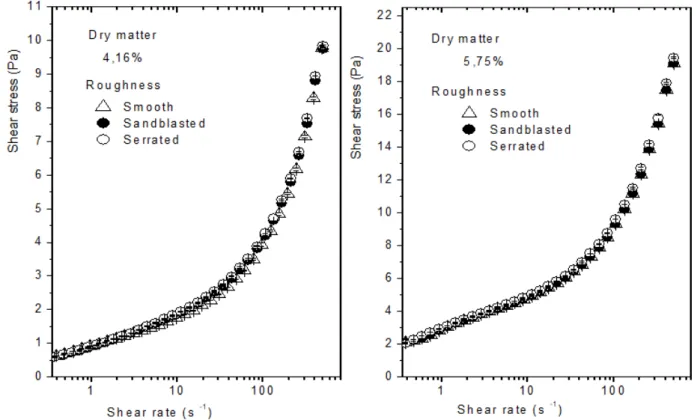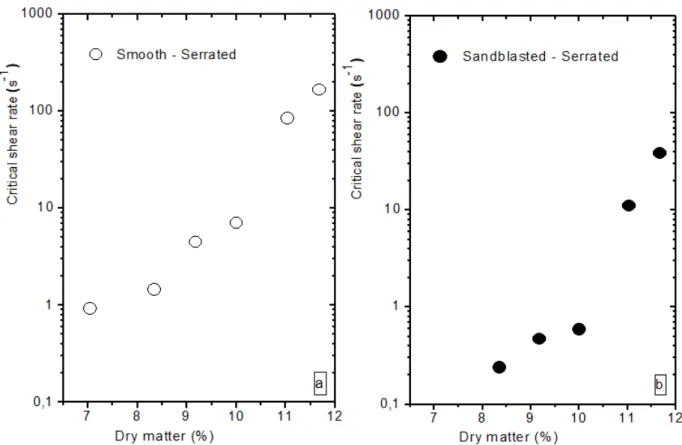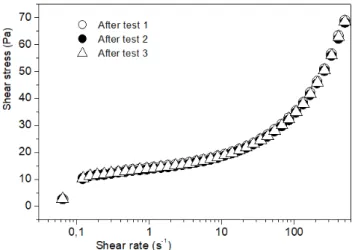HAL Id: hal-02470021
https://hal.archives-ouvertes.fr/hal-02470021
Submitted on 6 Feb 2020
HAL is a multi-disciplinary open access
archive for the deposit and dissemination of
sci-entific research documents, whether they are
pub-lished or not. The documents may come from
teaching and research institutions in France or
abroad, or from public or private research centers.
L’archive ouverte pluridisciplinaire HAL, est
destinée au dépôt et à la diffusion de documents
scientifiques de niveau recherche, publiés ou non,
émanant des établissements d’enseignement et de
recherche français ou étrangers, des laboratoires
publics ou privés.
rheological properties determination and advices to
perform reliable measurements
O. Thiene, E. Dieude Fauvel, J.C. Baudez
To cite this version:
O. Thiene, E. Dieude Fauvel, J.C. Baudez. Experimental difficulties often encountered with sludge
rheological properties determination and advices to perform reliable measurements. Applied Rheology,
Kerschensteiner Verlag, 2019, 29 (1), pp.117-129. �10.1515/arh-2019-0011�. �hal-02470021�
Appl. Rheol. 2019; 29 (1):117–129
Research Article
Oumar Thiène, Emilie Dieudé-Fauvel*, and Jean-Christophe Baudez
Experimental diflculties often encountered with
sludge rheological properties determination and
advices to perform reliable measurements
https://doi.org/10.1515/arh-2019-0011 Received Oct 01, 2018; accepted Feb 15, 2019
Abstract: Rheological parameters being of great
impor-tance for sludge process management, they are increas-ingly studied. However, experimental procedures may strongly impact their determination. Sample volume, mea-suring device depth and roughness but also mechanical history, have to be well-controlled to ensure reproducible results. Indeed, even if shear history can be erased with a sufficient preshear for diluted sludge, this paper clearly established that no steady state can be achieved for con-centrated sludge. The longer the shear history, the lower the rheological characteristics: Reproducible results are hardly obtained.
More importantly, slippage appeared to occur even with surfaces of moderate roughness and the phenomenon is all the more important that the dry matter is high. From all these observations, an experimental procedure based on the control of preshear and rest periods has been defined. Advices and precautions to observe are given in order to ensure reproducible and obtain unaltered results.
Keywords: Sludge, Rheology, Slippage, Shear history,
Ex-perimental procedure
PACS: 47.57.Qk, 83.85.Vb, 83.60.Bc, 83.60.Df, 83.60.La
1 Introduction
According to the UNO [1], 55% of the world population lived in urban area in 2014 and this fraction will increase
*Corresponding Author: Emilie Dieudé-Fauvel:Irstea, UR TSCF, Domaine des Palaquins, F-03150 Montoldre, France; Email: emilie.dieude-fauvel@irstea.fr
Oumar Thiène:Irstea, UR TSCF, Domaine des Palaquins, F-03150 Montoldre, France
Jean-Christophe Baudez:Irstea, UR TSCF, Domaine des Palaquins, F-03150 Montoldre, France; IMT Lille Douai, 941 rue Charles Bourseul, CS 10838, F-59508 Douai Cedex, France
up to 66% in 2050. Urban areas management will become one of the biggest challenges of the 21st century. As a direct consequence, wastewater management appears of crucial interest to protect public health and to ensure safe water supply. Sustainable urban areas thus imply high-performance wastewater treatment plants allowing to not only produce clean water but also to efficiently manage and recycle the residual sludge. High-performance sys-tems require process control, especially flowing properties measurements for pumping devices [2–4], mixers and aer-ation systems [3, 5]. This implies an accurate estimaer-ation of sludge rheological properties.
However, sludge undergoes continuous physical, chemical and biological changes from the inlet to the out-let of the plant, depending on the applied treatments. It starts with very diluted and untreated raw material and ends with stabilized and dewatered pasty material. From a rheological point of view, the diluted sludge may be con-sidered Newtonian [6] but as soon as the solid concentra-tion increases, the non-Newtonian characteristics become predominant [7–10]. Sludge can no longer be summarized by a single viscosity but by a viscosity function which usually decreases as the shear intensity increases [11].
However, the thicker the sludge does not necessarily mean the higher the solid content [12, 13]. Overall, the vari-able nature of sludge has a strong influence on its rheolog-ical characteristics [11].
Indeed, rheological properties may differ according to the implemented treatments [14, 15]. For example, anaero-bic digestion [16–18] or fermentation [11] induce a strong decrease of rheological characteristics.
Sludge origin and composition quantitatively impact the rheological behavior but they are not sufficient to explain the wide range of models found in the litera-ture which are mainly empirical and based on data fit-ting. Measured rheological properties may also differ ac-cording to the experimental procedure used [8, 19]: As of-ten described in the literature for non-Newtonian materi-als [20, 21], accurate flow curve determination implies the adoption of careful and well-controlled experimental
cedures to ensure reproducible results. These include ap-propriate geometry and experimental tests adapted to ma-terial characteristics ensuring data are fully representative of bulk properties. But this information is not systemati-cally mentioned in the literature.
In the literature, sludge is always presented as a non-Newtonian shear-thinning material [10, 22–24], possibly with a yield stress. [11, 25, 26], highlight both thixotropic colloidal suspension characteristics at high shear rate [27] and polymeric behavior at low shear strain [24].
Sludge flow curve determination is classically deter-mined by applying a stress sweep (respectively a shear rate sweep) [28, 29], to measure the corresponding shear rate (respectively shear stress) and to plot the shear stress ver-sus the shear rate on a diagram. However, as sludge is known to be thixotropic [27, 30], results are also impacted by mechanical history. To limit this impact, a preshear phase often followed by a rest period is usually considered to erase mechanical history [31].
When existing and defined, preshear duration and in-tensity differ from one paper to another [25, 32–34], possi-bly contributing to the results disparity, as preshear inten-sity and duration impact final results [19, 30, 35].
To summarize, contrary to what one might think, re-liable rheological measurements are not easy to perform and impacting factors have to be carefully considered. The way they are considered – or not – may affect final results. This paper intends to give some tips and precautions to take into account to ensure sludge rheological measure-ments are correctly performed.
2 Basis of experimental rheology
Rheology deals with the deformation and flow of con-densed matter under the influence of externally acting forces [36]. Usually, the focus is solely made on the (sim-ple shear) viscosity function, i.e. the relationship between the shear stress and the shear rate. This approach sounds reasonable when dealing with diluted materials for which lubrication theory apply [37] but it appears to be no longer valid as the solid concentration increases and elastic ef-fects appear [38], which is mostly always the case with wastewater sludge for which yield stress and elasticity are noticeable at around 2% solids [34, 39, 40].In viscometric flows, assuming that the temporal evo-lution of the material behavior is negligible, experiments often consist to establish the shear stress state through the
viscosity function (1):
η ( ˙𝛾) =τ ˙
𝛾 (1)
Shear rate ( ˙𝛾) and shear stress (τ) are deduced from torque and displacement measurements using specific equations depending on the geometry. The standard geometries usu-ally used are the concentric cylinders (also called the Cou-ette geometry), the parallel plates and the cone-plate ge-ometry. Among these geometries, the Couette one is the most frequently used [9, 41].
Equation (1) can be illustrated through Couette geom-etry.
A Couette geometry consists in concentric cup and bob (Figure 1), one rotating while the other remains immobile. Usually, the rotating device is the bob.
Figure 1: Schematic Couette geometry. M and φ are respectively the
torque and the rotational speed of the bob.
In such geometry, the shear stress and shear rate distri-butions are determined from the following equations [42]:
˙
𝛾= −r∂ ˙φ
∂r (2)
τr= M
where R1, R2and h are respectively the inner and outer
radius and the height of the cylinders, r is a radius between
R1and R2. These equations highlight that the shear stress
distribution is known and varies with r12 while the shear
rate distribution is not known and needs the knowledge of the velocity profile.
For an unknown fluid and by assuming that the tem-poral evolution of the fluid behavior is negligible, the be-havior law is of the form:
˙
𝛾= f (τ) (4) From (2), it can be deduced that:
˙ 𝛾= −r∂ ˙φ ∂r ⇐⇒φ =˙ R2 ∫︁ R1 ˙ 𝛾(r) r dr⇐⇒φ˙ (5) = −1 2 τ2 ∫︁ τ1 f (τ) τ dτ
The solution of (5) first implies to know the form of the equation fitting the rheological behavior of the material i.e. the functional relationship f between shear rate and shear stress must be known [43]. Second, it also implies the gap is fully sheared. Indeed, in the case of yield stress fluid for which an unsheared (dead) zone may exist, Equations (5) comes to: ˙ φ = Rc ∫︁ R1 ˙ 𝛾(r) r dr (6)
where Rc represents the critical radius between the
sheared and unsheared region.
Moreover, with a Couette geometry, the measured torque includes not only the contribution of the shear-ing of the vertical surfaces but also the shearshear-ing contri-bution of the top and bottom surfaces that have to be as-sessed [44].
3 Materials and methods
Dewatered sludge was sampled from the wastewater treat-ment plant then stored for several weeks before experi-ments to ensure the material is well stabilized, with negli-gible biological evolution. As a consequence, it can be as-sumed that sludge will have constant characteristics over one week, and used to check the reproducibility of the results. Moreover, after several weeks of storage, sludge turns into kind of homogeneous gel-like material (without visible flocs): This gel-like structure allows the use of a small gap and eases the calculation of shear rate and shear stress.
Dry matter was determined by drying the sample 24h at 105∘C. Initial dry matter was 18% and diluted samples were prepared from the original sludge by adding deion-ized water (see average dry matters in Table 1). Diluted samples were then stored for additional 24hours for com-plete hydration.
Table 1: Dry matter percentage (by weight) of the diluted samples.
Diluted samples Dry matter (%) Average Error 4.16 0.017 5.75 0.023 8.35 0.001 9.18 0.021 10.05 0.004 11.04 0.019 11.68 0.025
A well-known non-thixotropic yield stress hair gel (see description in Table 2) model material [45, 46] was also used to check whether the results discrepancies come from the material or from the rheometer and the experimental procedure used.
Before each rheological measurement, temperature was set-up at 20∘C (±0.1∘C) and as soon as the temperature target was reached, a rest period of 5 minutes was applied to ensure temperature homogeneity within the samples.
A Malvern strain-controlled Kinexus Pro rheometer equipped with a cup and bob geometry (inner cylinder: 34mm, outer cylinder: 36.2mm, length: 70mm) was used. The bob had 3 different roughness: Smooth, sandblasted (60µm of roughness) and serrated (150µm of roughness). For both the bob roughness, the cup roughness is 150 µm. The experimental procedure consisted in the application of an increasing shear rate ramp from 0.1s−1 to 500s−1 in 5mn. Despite its weaknesses, among which the nega-tive impact of inertia [19], the increasing shear rate ramp has been specially chosen to highlight how the final re-sults may be connected to the experimental procedure. Steady state behavior has also been determined by apply-ing constant shear rate steps of increasapply-ing intensities, un-til a steady shear stress has been reached.
Measurements were done in triplicate to evaluate the reproducibility.
Impact of sample volume and mobile depth on the flow curve have been first evaluated with the hair gel to en-sure changes only come from experimental setup. Table 2 summarizes the experimental setups.
Figure 2: Flow curves of the gel according to the mobile depth (a) or the sample volume (b). The gel represents 4.56% of the total mass of
the sample.
Then, for a given sample volume and bob depth, the impact of ramp duration has been observed by varying the duration from 2 minutes to 20 minutes.
For specific experimental conditions, the impact of mechanical history (preshear intensity ranging from 200 to 2000s−1and preshear duration from 5 to 30 minutes) on the final flow curve has been evaluated on diluted and con-centrated sludge.
Finally, for three different mechanical histories, the structural evolution during rest has been analyzed by ap-plying a 0.1% oscillatory shear strain with 1Hz of fre-quency, and by recording the elastic modulus over time.
4 Results and discussion
4.1 Impact of experimental setup and
surface roughness
Even with a model material, experimental data are im-pacted by mobile depth or sample volume (Figure 2): The higher the mobile depth, the higher the shear stress level. A similar trend is observed with the sample volume at a given mobile depth. For a given shear rate, the shear stress level increases linearly with the sample volume or the
mo-Table 2: Experimental setups for the hair gel. [Full name of the gel
(in French): Vivelle DOP Gel coiffant fixation extra-forte force 7].
Setups Mobile depth (mm) Sample volume (ml) Ramp duration (min) (1) 11 19.98 2 10 9 8 7 6 5 4 3 2 0.5 (2) 5 16.04 2 17.71 19.98 22.73 24.6 26.37
Figure 3: Shear stress corrective factor as a function of the mobile depth (a) or of the sample volume (b).
bile depth. However, by applying a corrective factor lin-early correlated to the mobile depth (Figure 3a) or the sam-ple volume (Figure 3b), all the flow curves are superim-posed (Figure 4). This corrective factor is obtained by re-ducing all stress levels to that corresponding to the mobile depth of 0.5 mm and the sample volume of 20 ml. Moreover, the corrective factor of both cases was found to be linearly linked to the normal force (Figure 5).
In the following, sample volume and mobile depth will be fixed at 20ml and 5mm. This depth corresponds to the Malvern specification for the considered geometry.
Roughness does not apparently impact the gel results (Figure 6a) even if some slight change can be noticed in the lower shear rate range (Figure 6b) suggesting the exis-tence of slight slippage when smooth but also sandblasted surfaces are used.
Slippage on smooth surfaces has been largely well documented in the literature [45, 47, 48] but more sel-dom on rough surfaces. Indeed, non-slippage condition is assumed to apply when the roughness is sufficiently high [49] which is the case with our serrated tools. How-ever Divoux, Tamarii [50] reported slippage with a gel de-spite a roughness of about 60µm, which is approximately the sandblasted one. Thus, using non-smooth surfaces is not a sufficient condition to prevent slippage.
When varying the slope of the ramp, flow curves are superimposed in the high shear rate range regardless the ramp duration but transient effects take place in the low shear rate range (Figure 7). The departure from the steady state curve appears at a critical shear rate which is all the more high that the ramp duration is short (see insert in Fig-ure 7). This could be caused by inertia [19] but the shear strain associated to this critical shear rate is constant (Fig-ure 8) indicating that transient regime is dominated by solid-like properties [46].
4.2 Impact of material nature: additional
diflculties when dealing with sludge
Low concentrated sludge is somewhere similar to the gels. Below a critical dry content (5.75% with our samples), no slippage is evidenced whichever the surface roughness (Figure 9). Mechanical history can be erased by applying a sufficient preshear in duration or intensity (Figure 10) and a steady state is reached.
However, for concentrated sludge, differences are no-ticeable. Slippage is systematically observed with the smooth surface and is all the more important that the solid concentration increases (Figure 11a). The same observa-tion can be made with the sandblasted surface (Figure 11b) for which slippage occurs above a higher solid
concentra-Figure 4: Flow curves of the gel after shear stress correction. The corrected shear stress is obtained by dividing the shear stress level by the
mobile depth corrective factor (a) or by the sample volume corrective factor (b).
Figure 5: Shear stress corrective factor as a function of the normal force from the mobile depth (a) or the sample volume (b) variations. The
Figure 6: Gel flow curves according to the surface roughness. The fig. b) is the zoom done in the area bounded by the dots in figure a).
The reference states of the samples are estimated following the elastic moduli when the material is on rest. For the serrated surface, the smooth surface and the sandblasted surface, the reference states are respectively 210.33 ± 0.22 Pa, 210.77 ± 0.33 Pa and 207.9 ± 2.86 Pa. The gel represents 4.56% of the total mass of the sample.
Figure 7: Flow curves of the gel according to the ramp duration. The
inserted figure is the zoom of the area bounded by the dots. The gel represents 2.71% of the total mass of the sample.
tion (7% here). As for the gel, and consistently with previ-ous studies [35], slippage magnitude is mainly noticeable in the low shear rate range and is more important with the smooth surface compared to the sandblasted one (the in-sert in Figure 12). No slippage is observed at high shear rates (Figure 12).
Figure 8: Critical strain of the gel according to the ramp duration.
The gel represents 2.71% of the total mass of the sample.
More importantly, no steady state is reached with con-centrated sludge (Figure 13). This result is highly ques-tioning as it means the rheological behavior of sludge is strongly connected to its mechanical history. Indeed, shear rate range and duration both impact the flow curve: The lower the slope, the lower the stress level of the flow curve, mostly at high shear rate (Figure 14).
This result simply comes from the overall shearing time sludge was submitted to: The lower the slope, the
Figure 9: Flow curve of the secondary semi-diluted sludge according to the surface roughness.
Figure 10: Preshear stress evolution of the semi-diluted sludge
according to preshear time. The preshear intensity is 1000 s-1.
longer the sludge is sheared for a given shear rate. The overall shear strain is higher as the slope is lower: Because mechanical history induces a decrease of the viscosity, the corresponding shear stress is lower.
The above-mentioned results explain why reported re-sults may vary from one operator to another with the same material. More importantly, they open up other problems related to sludge flowing properties such as wall slip condi-tions and the inevitable impact of the mechanical histories which appears to be fundamental characteristics to model the sludge flows along a treatment train.
Rheological measurement is not only the application of a shear rate ramp: Impacting factors have to be carefully considered. The way they are considered – or not – will modify the experimental results.
4.3 Experimental procedure definition for
sludge rheological measurements
As showed earlier, sample volume and mobile depth both impact the quantification of rheological parameters. Be-cause most of modern rheometers allow the control of the depth, this latest should not be a problem. However, the volume has to be carefully measured – and mentioned in the procedure – as it is an important parameter affecting the measurement.
The observed shift between results comes from the ex-cess volume above the bob which induce an additional shear stress. This additional shear stress is directly corre-lated to the normal force, meaning that shear stress and normal stress are interdependent. To ensure appropriate measurements, bobs often present a mark indicating the level of immersion to be respected.
With non-thixotropic materials, respecting the user conditions defined by the supplier or at least always using the same mobile depth and sample volume will allow
re-Figure 11: Critical shear rate slippage between smooth and serrated surfaces (a) or sandblasted and serrated surfaces (b) according to
the dry matter content. The critical shear rate is the lowest shear rate from which the flow curves of the corresponding roughness are superimposed.
Figure 12: Flow curves of a concentrated sludge according to the
surface roughness. The inserted figure is the zoom of the area bounded by the dots.
producible measurements. Unfortunately, neither the sam-ple volume nor the mobile depth is indicated in sludge rhe-ology literature. Even if it is expected these guidelines are followed, because results sometimes differ, the procedure should precise volume sample and mobile depth.
Figure 13: Yield stress evolution of the concentrated sludge
ac-cording to the preshear intensity. The duration is 5mn for a given preshear intensity. The yield stress is determined by fitting the flow curve with a Herschel-Bulkley model.
Moreover, it has been shown that slippage occurred even with rough surfaces and its impact is even all the more important that the solid content is high: The more concentrated the sludge, the more impacting the slippage, leading to a heterogeneous deformation [51] and to an un-derestimation of the yield stress, potentially leading to no apparent yield stress at all. Because slippage comes
Figure 14: Flow curves of the concentrated sludge according to
the ramp duration. The inserted figure is the zoom of the principal figure between 4s-1 and 400s-1. The dry matter of the samples is 10.05%.
from the interactions between material and measuring tool surfaces [52], roughness must be sufficient to avoid slippage: A highly concentrated sludge requires a higher surface roughness. Thus, as previously highlighted, rough-ness value is an important parameter to be mentioned as well. From our knowledge, a 0.5mm serrated surface ap-peared largely sufficient for biological sludge up to 12%.
When sludge displays a yield stress, which is the case when the solid content is higher than 2-3% [24, 27], the solid-like behavior is dominating as long as a critical shear strain has not been reached [53]. If a shear rate ramp is applied, the most frequent case in sludge rheology litera-ture [17, 22, 54], low shear rates may correspond to an over-all shear strain smover-aller than the critical one and sludge be-haves like a solid in this range [46], leading to a perturbed flow curve with again an underestimated yield stress.
Moreover, because of sludge thixotropic properties, stress level is also impacted by shear history: The longer the shear rate ramp, the lower the stress level and so the lower the apparent viscosity and the yield stress. Sludge appears to be more fluid that the ramp is low.
To neglect as much as possible these time-effects, an energetic preshear, in intensity and duration, is often ap-plied. However, it does not always allow the reset of shear history, especially when the sludge is paste-like (solid con-tent higher than 5%): As for the slope of the ramp, the more intense the preshear, the lower the shear stress level.
Consequently, an arbitrary, even long, preshear can-not help at reaching a reference state.
To ensure measurements are performed with a mate-rial at the same reference state, both preshear intensity and duration and/or rest duration have to be adapted to reach a reference level designed by the operator. This can
Figure 15: Stop condition of the preshear based on a shear viscosity
value of the sludge. The sludge dry matter represents 8.35%. The preshear intensity is 1000 s-1 for both the three preshears. The sample is put in rest until reaching an elastic modulus equal to at around 60 Pa after each preshear (see Figure 15).
Figure 16: Stop condition of the restructuration period based on an
elastic modulus value of the sludge. The preshear intensity is 1000 s-1 for both the three preshears.
be done by including a “stop condition” in the experimen-tal procedure: Preshear stops when a viscosity level has been reached (Figure 15) and/or rest stops when a restruc-turation level has been reached (Figure 16). In the latter case, when the elastic modulus reaches a ‘trigger’, the rest period ends and the next step starts.
This trigger allows a better reproducibility and a better comparison of the results. Indeed, adapting the preshear intensity and/or duration to reach a defined apparent vis-cosity representative of a given microstructure state ends to fully reproducible measurements (Figure 17).
Thus, preshear characteristics have to be considered as full part of the characterization procedure and must be well specified and representative of the process to be mod-elled.
Figure 17: Reproducibility of the sludge flow curve when a same
reference state based on the elastic modulus value is chosen. The elastic modulus reference is reported in Figure 15.
5 Conclusion
Sludge rheology literature sometimes present disparities. The origins of these disparities have been investigated and it has been shown that two main external parameters, sam-ple volume and mobile depth play a major role on results. Everything being equal, an increasing sample volume or mobile depth leads to an increasing level shear stress of the flow curve: These parameters impact the quantitative definition of rheological properties.
Besides, slippage inevitable occurs with concentrated sludge if the surface roughness is not sufficient and is the more important as the solid content is higher. Slippage may be high enough to apparently erase the yield stress, leading to inappropriate definition of the rheological be-havior.
Finally, as internal origin, the time-dependent behav-ior and the mechanical history of the sludge were found to strongly impact the rheological measurements. Because of its thixotropic properties, the throughout stress level of the sludge flow curve decreases with an increasing duration of the ramp.
As far as the mechanical history is concerned, getting a steady state by preshearing the sample is only possible for diluted sludge. For concentrated sludge, the longer the preshear, the lower the rheological characteristics, with-out reaching any plateau.
Thus, to ensure reproducible measurements, the fol-lowing experimental procedures have to be respected. First, the tool roughness must be sufficient to avoid slip-page: A 0.5mm serrated surface appeared largely sufficient for biological sludge up to 12%. Then, to control the impact of the edge effects on the experimental data, the sample
volume and the mobile depth must be fixed. Besides, to go over the mechanical history, the reference state must be linked to a setpoint and not to a preshear duration or inten-sity. As long as the setpoint value is not reached, the refer-ence state is not defined. The chosen referrefer-ence state must be also reported in measurements methods. Finally, the slope of the shear rate ramp and the full procedure must be adapted to the process to be modelled. Indeed, sludge rhe-ological measurements do not look at the determination of “definitive” rheological properties but more at the determi-nation of “accurate” rheological properties regarding the process and the usually interconnected previous steps.
Acknowledgement: The authors are grateful to the French
National Research Agency which granted the NEXT project (ANR-14-CE04-0010).
References
[1] UNO, Http://www.Un.Org/fr/development/desa/news/ population/world-urbanization-prospects.Html, Plus de la moitié de la population mondiale vit désormais dans des villes – ONU 2014.
[2] Eshtiaghi N., Markis F., Slatter P., The laminar/turbulent transi-tion in a sludge pipeline, Water Science and Technology, 2012, 65, 697-702.
[3] Seyssiecq I., Ferrasse J.-H., Roche N., State-of-the-art: Rheologi-cal characterisation of wastewater treatment sludge, Biochemi-cal Engineering Journal, 2003, 16, 41-56.
[4] Soller J.A., Olivieri A.W., Crook J., Cooper R.C., Tchobanoglous G., Parkin R.T., Spear R.C., Eisenberg J.N.S., Risk-based approach to evaluate the public health benefit of additional wastewater treatment, Environmental Science & Technology, 2003, 37, 1882-1891.
[5] Cornel P., Wagner M., Krause S., Investigation of oxygen transfer rates in full scale membrane bioreactors, Water Science and Technology, 2003, 47, 313-319.
[6] Sanin D.F., Effect of solution physical chemistry on the rheologi-cal properties of activated sludge, Water S.A., 2002, 28, 207-212. [7] Campbell H.W. and Crescuolo P.J., Use of rheology for sludge characterization, Water Science and Technology, 1982, 14, 475-489.
[8] Ratkovich N., Horn W., Helmus F.P., Rosenberger S., Naessens W., Nopens I., Bentzen T.R., Activated sludge rheology: A critical review on data collection and modelling, Water Research, 2013, 47, 463-82.
[9] Eshtiaghi N., Markis F., Yap S.D., Baudez J.C., Slatter P., Rhe-ological characterisation of municipal sludge: A review, Water Research, 2013,47, 5493-510.
[10] Papa M., Pedrazzani R., Nembrini S., Bertanza G., Should rhe-ological properties of activated sludge be measured, Applied Rheology, 2015, 25.
[11] Baudez J.C. and Coussot P., Rheology of aging, concentrated, polymeric suspensions: Application to pasty sewage sludges, Journal of Rheology, 2001, 45, 11-23.
[12] Spinosa L. and Wichmann K., Sludge characterization: The rôle of physical consistency, Water Science and Technology, 2004, 49, 59-65.
[13] Baudez J.C., Rhéologie et physico-chimie des boues résiduaires pâteuses pour l’étude du stockage et de l’épandage, Thèse à l’Ecole Gationale du Génie Rural, des Eaux et des Forêts, 2001. [14] Lotito V., Spinosa L., Mininni G., Antonacci R., The rheology of
sewage sludge at different steps of treatment, Water Science and Technology, 1997, 36, 79-85.
[15] Abu-Orf M. and Dentel S., Effect of mixing on the rheological characteristics of conditioned sludge: Full-scale studies, Water Science and Technology, 1997, 36, 51-60.
[16] Monteiro P.S., The influence of the anaerobic digestion process on the sewage sludges rheological behaviour, Water Science and Technology, 1997, 36, 61-67.
[17] Dieude-Fauvel E., Heritier P., Chanet M., Girault R., Pastorelli D., Guibelin E., Baudez J.C., Modelling the rheological properties of sludge during anaerobic digestion in a batch reactor by using electrical measurements, Water Research, 2014, 51, 104-12. [18] Zhang J., Haward S.J., Wu Z., Dai X., Tao W., Li Z., Evolution of
rheological characteristics of high-solid municipal sludge during anaerobic digestion, Applied Rheology, 2016, 26, 32973. [19] Baudez J.C., About peak and loop in sludge rheograms, Journal
of Environmental Management, 2006, 78, 232-239.
[20] Ahonguio F., Jossic L., Magnin A., Influence of surface properties on the flow of a yield stress fluid around spheres, Journal of Non-Newtonian Fluid Mechanics, 2014, 206, 57-70.
[21] Roberts G.P. and Barnes H.A., New measurements of the flow-curves for carbopol dispersions without slip artefacts, Rheolog-ica Acta, 2001, 40, 499-503.
[22] Slatter P.T., The rheological characterisation of sludges, Water Science and Technology, 1997, 36, 9-18.
[23] Rosenberger R., Kubin K., Kraume M., Rheology of activated sludge in membrane bioreactors, Engineering in Life Sciences, 2002, 2, 269-275.
[24] Baudez J.C., Markis F., Eshtiaghi N., Slatter P., The rheological behaviour of anaerobic digested sludge, Water Research, 2011, 45, 5675-80.
[25] Mori M., Seyssiecq I., Roche N., Rheological measurements of sewage sludge for various solids concentrations and geometry, Process Biochemistry, 2006, 41, 1656-1662.
[26] Hammadi L. and Ponton A., Rheological investigation of vase of dam: Effects of aging time, shear rate, and temperature, Applied Rheology, 2017, 27.
[27] Baudez J.C., Physical aging and thixotropy in sludge rheology, Applied Rheology, 2008, 18, 13495.
[28] Stokes J.R. and Telford J.H., Measuring the yield behaviour of structured fluids, Journal of Non-Newtonian Fluid Mechanics, 2004, 124, 137-146.
[29] Nguyen Q.D., Akroyd T., De Kee D.C., Zhu L., Yield stress measure-ments in suspensions: An inter-laboratory study, Korea-Australia Rheology Journal, 2006, 18, 15-24.
[30] Tabuteau H., Coussot P., Baudez J.C., A new approach to the thixotropic behaviour of sewage sludge, Journal of Residuals Science and Technology, 2006, 3, 233-240.
[31] Coussot P., Rhéophysique la matière dans tous ses etats, EDP sciences, 2012.
[32] Hammadi L., Ponton A., Belhadri M., Rheological study and val-orization of waste sludge from wastewater treatment plants in the dredging operation of hydraulic dams, Energy Procedia, 2011,
6, 302-309.
[33] Mori M., Isaac J., Seyssiecq I., Roche N., Effect of measuring ge-ometries and of exocellular polymeric substances on the rheolog-ical behaviour of sewage sludge, Chemrheolog-ical Engineering Research and Design, 2008, 86, 554-559.
[34] Segalen C., Dieude-Fauvel E., Baudez J.C., Electrical and rheo-logical properties of sewage sludge-impact of the solid content, Water Research, 2015, 82, 25-36.
[35] Tabuteau H., Baudez J.C., Bertrand F., Coussot P., Me-chanical characteristics and origin of wall slip in pasty biosolids,Rheologica Acta, 2004, 43, 168-174.
[36] British Standards Institution B., Methods of test for soils for civil engineering purposes, 1975.
[37] Batchelor D.B., Parametric resonance of systems with time-varying dissipation, Applied Physics Letters, 1976, 29, 280-281. [38] Tanner P.A., Luminescence and radiative decay of er3+in
cs2naercl6, Molecular Physics, 1988, 63, 365-385.
[39] Markis F., Baudez J.C., Parthasarathy R., Slatter P., Eshtiaghi N., The apparent viscosity and yield stress of mixtures of primary and secondary sludge: Impact of volume fraction of secondary sludge and total solids concentration, Chemical Engineering Journal, 2016, 288, 577-587.
[40] Slatter P., The rheological characterisation of sludges, Water Science and Technology, 1997, 36, 9-18.
[41] Couarraze G. and Grossiord J.L., Initiation à la rhéologie, 1983. [42] Coleman B.D., Markovitz H., Noll W., Viscometric flows of
non-newtonian fluids: Theory and experiment, Springer Tracts in Nat-ural Philosophy, 1966, 5.
[43] Steffe J.F., Introduction to rheology, Rheological methods in food process engineering, 1996, 2, 1-93.
[44] Coussot P., Rhéophysique la matière dans tous ses états, EDP sciences, 2012.
[45] Piau J.M., Carbopol gels: Elastoviscoplastic and slippery glasses made of individual swollen sponges, Journal of Non-Newtonian Fluid Mechanics, 2007, 144, 1-29.
[46] Ovarlez G., Cohen-Addad S., Krishan K., Goyon J., Coussot P., On the existence of a simple yield stress fluid behavior, Journal of Non-Newtonian Fluid Mechanics, 2013, 193, 68-79.
[47] Balmforth N.J., Frigaard I.A., Ovarlez G., Yielding to stress: Recent developments in viscoplastic fluid mechanics, Annual Review of Fluid Mechanics, 2014, 46 121-146.
[48] Poumaere A., Moyers-González M., Castelain C., Burghelea T., Unsteady laminar flows of a carbopol® gel in the presence of wall slip, Journal of Non-Newtonian Fluid Mechanics, 2014, 205, 28-40.
[49] El Kissi N., Nigen S., Pignon F., Glissement et rhéométrie, Rhéolo-gie, 2006, 21, 13-39.
[50] Divoux T., Tamarii D., Barentin C., Manneville S., Transient shear banding in a simple yield stress fluid, Physical Review Letters, 2010, 104, 208301.
[51] Bertola V., Bertrand F., Tabuteau H., Bonn D., Coussot P., Wall slip and yielding in pasty materials, Journal of Rheology, 2003, 47, 1211.
[52] Ballesta P., Petekidis G., Isa L., Poon W.C.K., Besseling R., Wall slip and flow of concentrated hard-sphere colloidal suspensions, Journal of Rheology, 2012, 56, 1005-1037.
[53] Coussot P., Tabuteau H., Chateau X., Tocquer L., Ovarlez G., Aging and solid or liquid behavior in pastes, Journal of Rheology, 2006, 50, 975-994.
[54] Eshtiaghi N., Yap S.D., Markis F., Baudez J.C., Slatter P., Clear model fluids to emulate the rheological properties of thickened digested sludge, Water Research, 2012, 46, 3014-3022.
